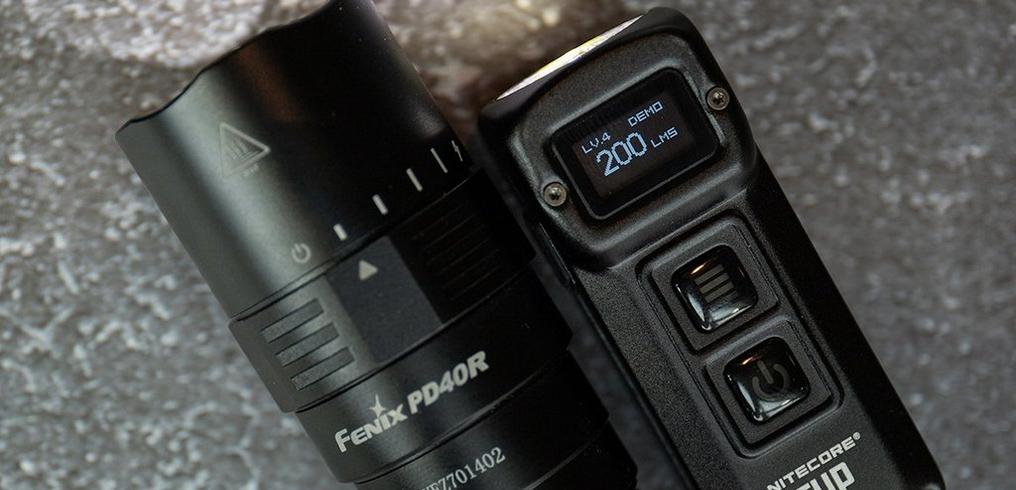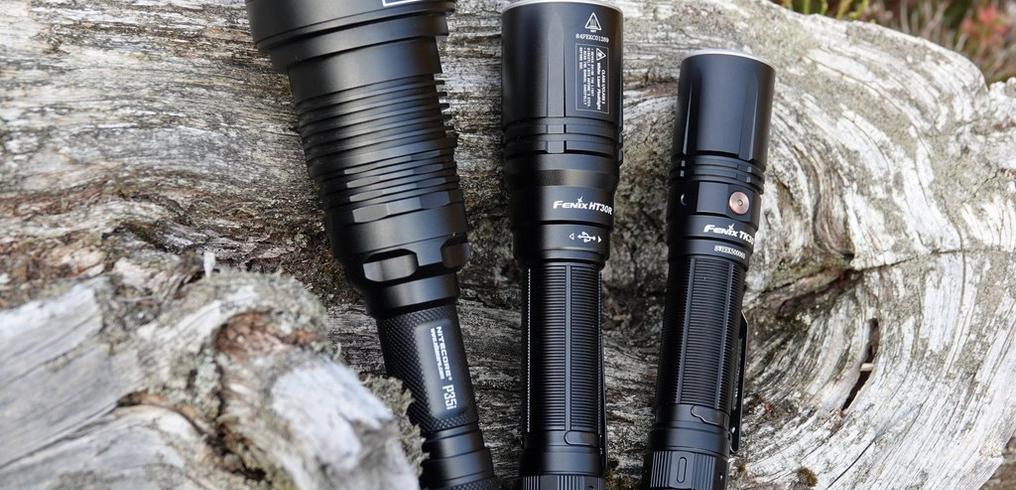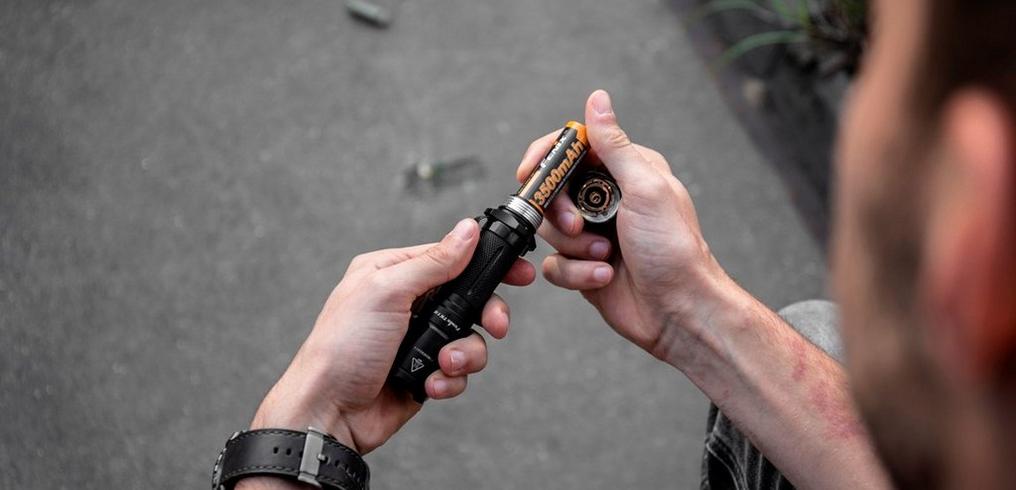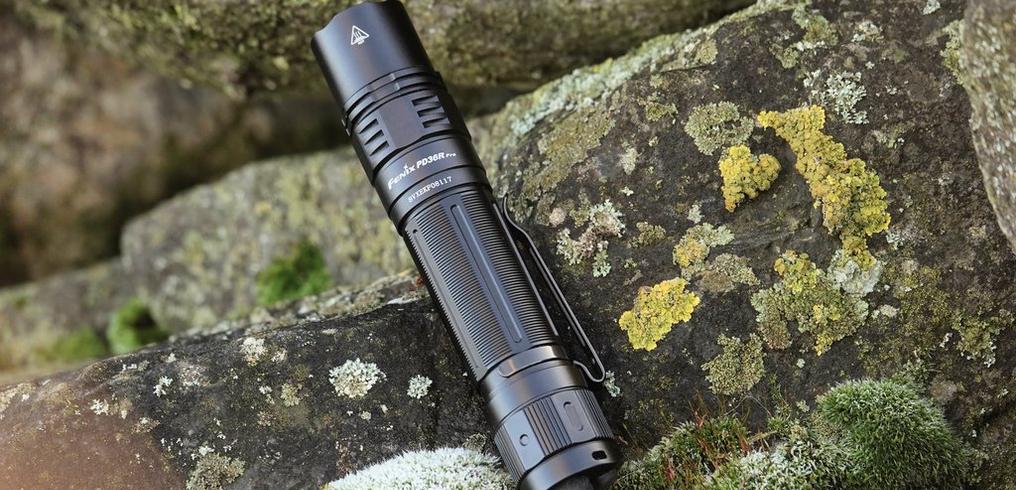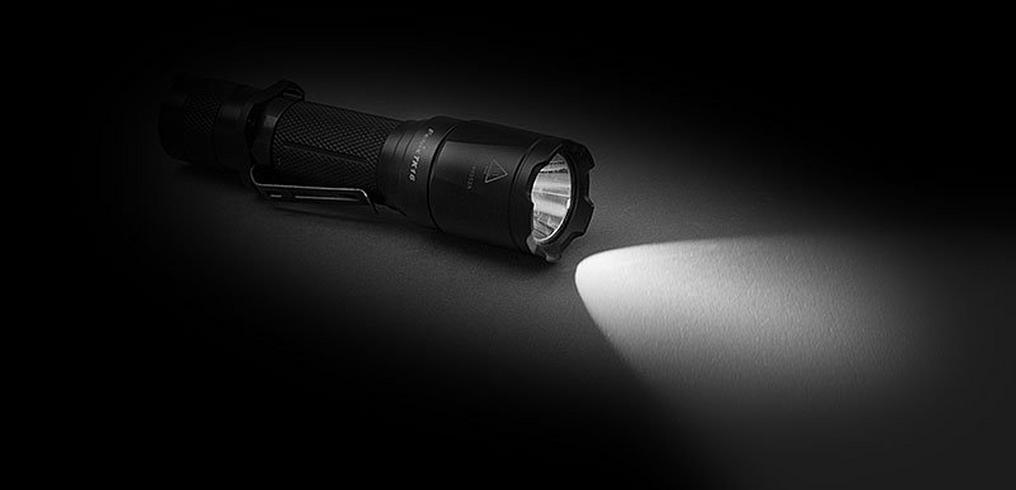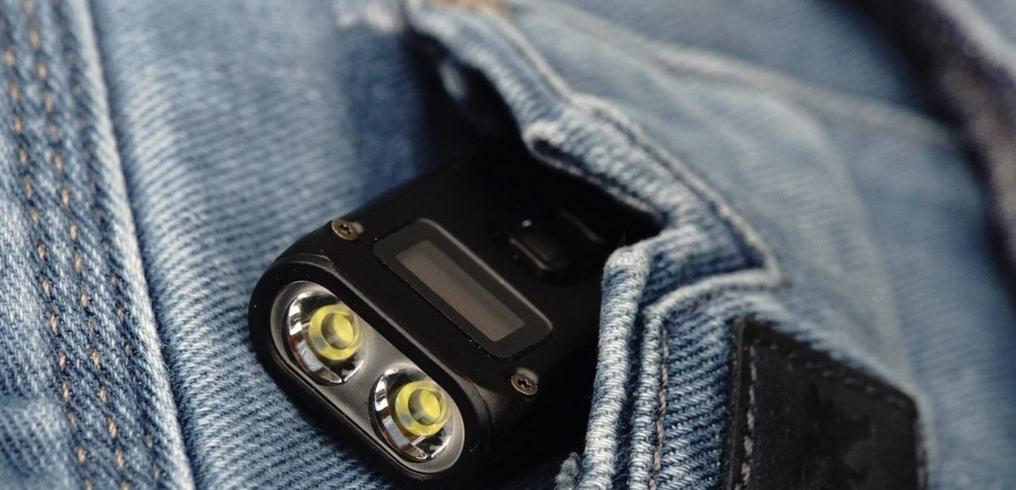5 head torches put to the test | Expert Review by Koen van der Jagt
In our previous review we looked at which popular flashlight is best for daily use, you can read more about it here. So yes, a good light is incredibly practical; however, you will often be faced with situations where you want to have both your hands free but still need light. Think of working around the house, exercising or reading a map. The solution: a head torch!
When it comes to head torches Knivesandtools also has a lot to offer. You can find dozens of head torches on the site in almost any price range. This could make your choice, however, slightly more difficult. That is why I will help you out by taking a closer look at five head torches from the popular price range and share my experiences. As usual I will discuss the first impressions, the options and the ease of use first. Afterwards I will discuss one of the most important aspects: the light output. To properly test it we will visit one indoor and one outdoor location to get a good idea of what the candidates are capable of. Enjoy!
The candidates
At Knivesandtools you can choose from a wide range of head torches; varying from a simple light to expensive 'high-end' models. The approach of this test was to check out different models in the mid-range segment, well-suited for daily use. The prices are roughly between forty and sixty pounds; which is slightly more than when you purchase a light at the hardware store. However, each user will agree with me after purchasing a quality light that it was well worth the money. Let me introduce the candidates, from the cheapest to most expensive: The Nitecore NU25, the Fenix HL12R, the Petzl Actik Core E99ABA, the Princeton Tec EOS and the LedLenser MH6. Great options, with each their own features. Is the most expensive the best? We will see!
Unboxing
Each manufacturer has his own vision when it comes to wrapping their products. The result is that each product is differently wrapped. Some boxes can easily be opened and offer you enough room to also store the torch; others are basically 'sealed in' in hard plastic packaging. I don't like cutting open plastic cases, but with the Princeton Tec, NiteCore and the Petzl torches you can't escape the use of a knife or scissors. LedLenser and Fenix did a better job, especially LedLenser paid close attention to the stunning box. In terms of contents they are basically all similar. The Priceton TEC only gives you the bare minimum, so the light, batteries and manual. The other lights, however, also don't give you a lot of extras; only a charging cable. The Petzl does come with a sticker, perhaps fun to add it to your gear. You won't find any replacement parts such as rings or spare buttons. I do have to say that a head torch doesn't 'wear' out as fast a flashlight, which justifies the manufacturers choice. Fortunately all lights are delivered 'ready-to-be-used', so including battery. The LedLenser MH6 clearly has the most practical and better-looking box, I am simply not a fan of the blisters: You won't be able to neatly close these after you have cut them open.
Size and weight
A key aspect that definitely counts when you make a choice! All torches are fairly different when it comes to size. And the lower the weight, the better the wearing comfort will be; in most cases you will be wearing the light on your head. One of the torches clearly stands out here: the NiteCore NU25. Not only really compact and flat, it also only weighs 52 grams! As such it is the lightest of all the torches. After that comes the Fenix HL12R, of which the casing is already twice as thick as the NiteCore! With a weight of 77 grams this head torch is also considered to be a 'light-weight' torch. Shortly after is the Petzl Actik Core: the design of the casing is clearly thicker than the Fenix; with a weight of 81 grams it also isn't heavy. The casing of the LedLenser is even thicker, especially when you focus the beam and the head 'zooms in'. The scale displays a weight of 93 grams, so this light (with included battery) is again a little heavier. The Princeton EOS is, in terms of size, similar to the LedLenser, in terms of weight, however, it isn't as the scale displays a weight of 100 grams. This means that this torch weighs almost twice as much as the NU25! You will really notice this difference, especially while running or during any other similar activity. The NiteCore is clearly the winner here, followed by the Fenix and the Petzl.
Power supply
The 'USB age' also has its advantages when you look at head torches: most torches can be charged via a micro-USB port. With the Fenix and the NiteCore this is easiest; plug and play so to say. The batteries are built-in, the charging port located in the casing of the light. The advantage is that it prevents wear and tear and that the lights guarantee a better watertightness: you never have to open them. The disadvantage is that it is difficult or impossible to replace the battery. This is where the LedLenser and the Petzl stand out. They come with a directly rechargeable battery that basically replaces three AAA batteries. These can be rechargeable and non-rechargeable AAA batteries. So if your battery is dead you can quickly add a set of alkaline batteries and continue with whatever you were doing! Petzl and LedLenser definitely thought about this! The Princeton Tec works with three AAA batteries; these can be alkaline, rechargeable or lithium batteries. Here you also have multiple options. As such you are never 'forced' to use the same type of battery and you will always have multiple options. The Fenix and the NiteCore are easiest, you don't have to think about a battery because it is already built-in. However, the carefully thought out Petzl and LedLenser systems offer you more security when you need the light for a longer period of time and do not have a charger at your disposal. With a pack of spare alkaline batteries you can go a long way!
Light sources
Also good when purchasing a head torch is looking at the light source it uses; there are namely dozens, if not hundreds of LED lights on the market today. The LED light influences the profile and the total output. I will discuss the light sources per light, the candidates in alphabetical order.
The Fenix Hl12R has, as a white LED light, the XP-G2 version in the neutral white version. A fairly commonly used light source in head torches because it supplies you with enough power and a fairly wide light image. The red light on the Hl12R is a Nichia LED light: Not very bright, but more to be seen or to use while reading. LedLenser, as we know, doesn't really give detailed information about the light source: The white LED of the MH6 is a 'Power LED light', the red isn't mentioned by name in the manual. The main light source has a cold-white colour, the red LED light is clearly more powerful than that of the Fenix. The NiteCore NU25 also has an XP-G2 (S3), which is fairly similar to the one used for the Fenix HL12R. Also in cold-white, but the NU25 has an additional white LED light with a high CRI, this means that it takes care of a very natural rendering of colours. The red LED light, which was not given a type number, gives pretty bright and more scattered light. The light sources of the Petzl Actik Core are also not listed; there is nothing mentioned on the box or in the manual. Both white LED lights have a cold light colour, the red LED light is fairly bright. The Princeton Tec has, according to the box, been enhanced with a 'Maxbright-LED light', so it is also not really clear what is hidden behind the lens of the EOS. The colour of the light is also cold-white for this head torch; the neutral-white lights are therefore a minority. A red light is missing from the Princeton Tec EOS.
Later on in this review I will talk more about the light sources and also show you more with photographs!
First impressions
Compared to most flashlights most of the tested head torches are made from plastic. Not really surprising because this is the easiest way to 'save' weight. The Fenix HL12R and the NiteCore NU25 are the exception, these lights are also enhanced with aluminium or metal. It immediately makes the lights look a lot better. Especially the material used for the Princeton Tec and the Petzl Actic Core look somewhat cheap: it also looks like plastic. In terms of overall finish these lights leave the least strong impression. The Princeton Tec EOS has a very thin plastic lens that is sensitive to scratches. With the Petzl Actik Core the seams of the casing of my edition don't seem to match well. For the NiteCore, the LedLenser and the Fenix all looks well. Especially the latter is decently constructed.
The NiteCore NU25 is the smallest of the bunch. A flat head torch, without parts sticking out; basically everything about this light has been minimized, without it coming across as too small. I personally feel that the design looks great; the many accents look great on this light. A couple of striking details are the 'rough' lens that is placed in front of the secondary LED lights. It takes care of a better distribution of the light. The relatively shallow lens of the XP-G2 S3 LED light has an 'orange-peel-reflector'. Also intended to reduce the concentration of the light beam from the lens. The headband is nice and thick and has a special strip on the inside to get rid of sweat. The NU25 is a real light-weight torch, with a practical design with good 'looks'.
As I mentioned before the Fenix Hl12R radiates class: Anyone who is familiar with this brand will know what I mean. Clearly thicker than the NiteCore, which is mostly the result of the lens that is sticking out. The HL12R might remind you of a compact camera in terms of design. The aluminium used makes the torch look slightly better than the rest; in addition, this material ensures that the light can handle quite a lot. Striking about the lens is the tilted XP-G2-LED light surrounded by a reflector with a type of internal reflection that spreads the beam. Another striking detail is the transparent casing that enables you to look inside the HL12R. The headband is nice and tight and has a rough inside to make sure it won't slide off when you use it. I think it is the most robust of all the torches but still has a beautiful and compact design.
The Actik Core of Petzl has (when looking at it from the side) a triangular design; the lights are therefore always pointing downwards. This torch clearly has more coated plastic and, as such, looks a little 'cheap' unlike the Fenix and the NiteCore. The 'front' of the light, however, does look great with the double light and the extra red LED light. Unlike the NiteCore and the Fenix the Petzl can be opened. Inside it looks great, the battery fits nicely. The three LED lights are placed in smooth reflectors, which are generally speaking not deep. Makes sense because a head torch is not often used to shine very far. Striking details on the Actik Core are the large pressure switch and the structure of the lenses, both of which scatter the light beams in a different way. The headband is slightly narrower, but stays nicely in place. Special detail: the headband contains a whistle. It can be a lifesaver when you find yourself in an emergency situation; it is a great find! In terms of overall finish the Actik Core cannot live up to the Fenix and the NiteCore, this, however, doesn't mean that the torch is badly constructed.
The LedLenser MH6 consists of more than two parts: the rear with the battery and the lens with the separate casing. The fact that the light is thicker than the rest is the result of the advanced focus system LedLenser patented. After all, a 'zoom lens' simply needs more space. Because LedLenser (optically speaking) uses a lot more plastic the MH6 is more than solidly constructed. Everything is neatly in place and the finish is great. Only the warning sticker to not look into the light could come off when used. The LED light is neatly placed in the middle of the light behind the lens; various rings are visible in the reflector. Hopefully we don't see too much of this in the light image, something we will definitely look at later on. When you open the light you immediately notice the thick white rubber ring that protects the battery compartment from water. Other than that you won't find any anomalies here: The battery or batteries nicely fit between the contacts. Striking details on the MH6 are the translucent casing and the light head which you can use to zoom in and out. The headband feels a little looser than, for instance, the one that comes with the Fenix head torch and is also a little thinner. I would have loved for it to be a little thicker with a slightly rougher structure, specially since we are dealing with quite a large head torch. The construction quality and the finish of the MH6 is great.
The Princeton TEC is the heaviest of the five torches and also has a look and feel all its own. The design is slightly unique, but I do not think it looks ugly. Despite its plastic 'looks' the light is decently constructed. It appears that the LED light is not completely placed in the middle. The lens, which appears to be very sensitive to scratches has a type of built-in magnifying glass that ensures that the hotspot of the light beam gets a 'boost' and reaches slightly further. To reach inside the battery compartment you need to loosen the screw; after placing the batteries you can also easily secure the cap without using a screwdriver. The batteries can also easily be placed. Another striking aspect of the Princeton Tec EOS is the large switch on top of the light. It is embedded in the design but easy to find because of the use of edges and different heights. The headband is simple and could, in my opinion, have been wider. The slightly large and heavy EOS is decently constructed, even though the plastic-feeling dominates a bit with this light
User experiences and options
Compared to a flashlight (where, for instance, the shape and ease of use are key) the weight and carrying comfort are key when it comes to a head torch. In my eyes a great head torch is one which you can use for jobs for which you need both hands, but also one that won't wear you out as you wear it during a hike or run. Especially when running a light-weight torch is great, a torch that 'sags' can become annoying while you work out. Of course for some users weight and size won't be such a big deal because they will only use the light for a short period of time. One other thing: a small light also often means smaller control buttons; something to consider when you're doing heavy work while wearing gloves. As mentioned before the NiteCore NU25 is the lightest and most compact torches of the five, followed by the Fenix HL12, the LedLenser MH6. The Petzl Actik Core and the Princeton Tec EOS. I personally feel that the NiteCore and the Fenix are nicest to wear, thanks to the low weight and the comfortable wide, solid headband. Fenix also enhanced the headband with rubber for an even better grip. Especially the LedLenser headband feels a little looser and is also a little narrower. Adjusting the headband works the same for all five head torches: you basically 'slide' the band to reach the right length. It might take some getting used to but it is effective and simple.
Most torches from this test are USB-rechargeable. You charge the Fenix and the NiteCore via the built-in port, with the LedLenser and the Petzl you need to open the light to reach the battery pack. You can take it out or charge it while you leave it in. With the Princeton Tec you need to remove the batteries. A tip for the LedLenser, the Princeton and the Petzl: Always make sure you carry a set of additional spare alkaline batteries; as such you will never be without power. About the run times (how long a light functions with a battery charge): This is an advantage for the bigger torches in this test. You can, for instance, see that the Princeton Tec EOS can last a lot longer than the NiteCore with a comparable light output. Something to take into account when you plan to use a light for a long period of time. All candidates easily last a couple of hours when you use them in the middle mode. The highest mode of the NiteCore and the Fenix are so-called 'burst-modes', which means that they are meant to have a lot of light at the ready for a short period of time. To protect the light from overheating you can only use this mode for a limited period of time, with a maximum of 1 or 2 minutes.
An important aspect here is ease of use: while carrying the light on your head you need to be able to easily find the on/off switch and select the right light mode while walking in the dark. Each manufacturer has his own idea about how to handle it because no interface is the same. The switches on the Petzl and the Princeton Tec are easiest to find thanks to the large size. The button on the LedLenser is clearly smaller, but slightly sticks out and is made from a different material than the casing. As such you can also easily find it. The Fenix has two similar buttons on top of the torch, both on the left and the right side. As such you will need to know beforehand which side you need to select the right mode. The NiteCore has two switches that are almost touching each other. Because they are fairly small it is more likely to make a mistake than with any of the other torches. The button on the Petzl is hard to miss. This could be great when you often work with gloves because at that point the large switches can definitely come in handy.
The Fenix has two buttons. You use the left one for the power check by pressing it down briefly. One to four lights will light up and give you the status of the battery. If you press down longer you will activate the red light. Click again and you will end up with the white SOS-mode, followed by the red flashing mode. So the left button is used for the special modes. With the right button you turn on the white modes by pressing down for a longer period of time. Afterwards you can switch between light modes by clicking. When you press down longer the torch will be turned off. You reach the burst mode by continuously pressing down the right mode until the turbo mode is activated. This is possible when the light is on and off. The Fenix remembers the last-used white light mode, except for the burst-mode. This is in the only light in the test that is capable of doing so and I am a fan of this option. The interface of the Fenix isn't that hard, you quickly get the hang of it and it works without a hitch.
The LedLenser only has two white light modes, I would have loved to see a couple more. By clicking the button you turn on the MH6 in the highest mode, after which you can switch to the low mode and the white flashing mode. Switching to the next light mode is only possible when you are quick because after a couple of seconds this is no longer possible: once selected the chosen light mode is 'fixed' and will go off with the following click. I keep thinking this is rather peculiar. This torch also doesn't have a mode-memory: it won't remember the mode last used. To get the red light going you need to hold the switch down from standby as long as it takes for the light to switch from red to white or vice versa. In the red mode you can turn on the red light with one click, the next step is flashing red and the final step is turning the light off. The LedLenser is easy to use thanks to the good pressure point of the switch, but it has a somewhat peculiar interface. Because you always have to turn the light on in the highest mode this could be annoying when someone is sleeping next to you in a tent. This light is the only one that can be focused; this is very easy and can be practical when you want to light up a part under the hood of your car, for instance.
The Petzl has a large switch with which you need to check all the options. The pressure point of the button lies a little deeper, but the light will immediately do what you ask of it. The interface is similar to the one on the LedLenser. With the first click you turn on the Actik Core in the lowest mode (with only the left LED light), afterwards you turn on the double LED light in the middle mode and the double LED light in the highest mode. After that the light will be turned off. The same also applies here: after turning the light on you have a couple of seconds to select the desired light mode before it is 'fixed' and turns off after the following click. I do not find this practical because I often find myself looking for a little bit of extra light when I use my head torch and therefore wish to switch as I use it. This is not possible with the Petzl and the LedLenser because you can no longer change the light mode after three seconds. Well, only after turning the light on and off again. Fortunately the Petlz starts with the lowest light mode. On the Petzl you can also switch between red and white light by holding down the switch in the standby-mode long enough until the colour changes. The Petzl also allows you to choose between white and red while the light is turned on, this is done in the same way. If the light is set to the red mode you will first have continuous red light, followed by flashing light after which it is turned off. Technically speaking the controls of the Petzl work fine, practically speaking it has some peculiarities. The choice between a single or double LED light is a nice find.
The NiteCore has a double switch which isn't superfluous because this light has, by far, the most options of the five head torches put to the test. The left button is for white, the right for red light. A single click turns on the lowest white mode, with the following click you will, respectively, get the medium mode, the high mode, after which it turns off. NiteCore also 'locks' the mode after a couple of seconds. This means that (after approximately 5 seconds) you need to turn the light off and on again to select the desired light mode. The NU25 also doesn't remember the mode last used. You activate the highest 'burst' mode by holding the switch down when the light is turned on and uses white light. You turn on the secondary white LED light by holding the left button down in the standby mode. With the right button you bring the red LED light to life, starting with the lowest mode, followed by the high mode and the flashing mode, after which you turn it off. An additional option is hidden in the right button: by pressing it down a long time (in standby) the light will give you the right battery status. Practical option which you will only find on the NiteCore and the Fenix. For the Nu25 NiteCore was therefore able to find a good way to easily find all the options; I would have preferred the torch (especially in the white mode) to remember the last mode I used. The buttons are very small and look too much alike, as such the light is not great when wearing gloves or for very large hands.
The Princeton Tec only has one switch that is slightly hard to press. As such you sometimes have to click again before it responds. After the first click the EOS starts in the highest mode, after which you can switch to the medium, low and flashing mode after which you turn it off. You can also immediately turn the light off in any specific mode by holding the button down a little longer. The torch doesn't remember the last mode so you will always turn the light on in the highest mode. This light is a great option for users who don't like too complicated torches and prefer the light to start in the highest mode. I feel the Princeton Tec EOS responds a little too slow during use and I would love to see that the torch remembers the last-used mode
Light image and light colour
It is remarkable that all torches have their own light image, even more proof that each manufacturer has his own vision and deals with it differently. Each light, for instance, has its own beam angle: the larger the angle, the wider the path you light up with your torch. A narrower beam (so with a smaller angle) has more reach: Practical, for instance, when your speed is higher; you have more time to respond to obstacles if you see them sooner. The colour of the light is also an important feature you perhaps never paid attention to... A LED light with a more neutral colour makes everything you highlight in the dark look more natural, while a colder colour reaches further. In addition, a neutral colour works better in humid surroundings, think of fog or high humidity. Only two of the five candidates are enhanced with a neutral light colour: the NiteCore NU25 and the Fenix HL12R. The rest of the torches have a colder light colour. In the following chapter I will clarify with photographs
Beamshots
Now on to the most important aspect of a torch: the output and the light image! Among the five tested, there are still considerable differences in terms of lumens. Can you clearly see this? To give you a clear idea of what this looks like in 'real life' I will give you the so-called 'beamshots'. I take beamshots by placing the camera on a tripod and adjusting the shutter to a couple of seconds. To keep things fair I took all photographs at the same distance.
The first site is a storage warehouse with some caravans. This gives you a clear idea of how these head torches function on the camp site. A nice side effect is that the white caravans also clearly show you the colour of the torches. We start with the white LED light in the highest mode. To keep things clear the five torches in alphabetical order
Except for the Priceton Tec EOS the lights also have red light; there are clearly also some differences here. Below the photographs!
Let's head outside. The location is a footpath with stairs about forty meters away. Unfortunately it wasn't completely dark out here because of the light pollution of a large industrial area. Once again the lights at alphabetical order in the highest mode; this time really as a head torch!
Let's head to another site! This time two large trees located about 25 meters away. The photographs were taken from the back to make sure you can clearly see how the light image relates to the person.
Now for the red and/or secondary option of four lights. Because red often doesn't reach that far I took some photographs close to some white blocks that were lying in front of me.
Strengths and weaknesses/ Conclusion
When I take the strengths and weaknesses of all torches into account I am personally inclined to choose the more compact and light-weight torches. So the Fenix HL12R and the NiteCore NU25. Also in terms of ease of use these products do really well, they are a little easier to control and use than the other candidates. The Fenix feels a little more robust and a little more solid on your head, is easier to check thanks to the large buttons and will always remember the mode last used. You barely feel the NiteCore thanks to its weight, it has more light modes (among which a nice warmer colour) and it scores well in terms of red light. Charging is similar for both lights and doesn't cause any problems.
So are the other lights that bad? Absolutely not! However, they are little larger and also weigh more. In addition, their controls take some getting used to. The LedLenser has a unique focus system; the MH6 is better than all other lights in terms of reach. And what about the option of using both a rechargeable battery and AAA batteries? For many users this could be the reason to purchase this light. The same applies to the Petzl Actik Core, which also has a great red light and.. The emergency whistle in the headband. The Princeton Tec EOS is not the brightest, but is decently constructed and will definitely not let you down. The no-nonsense head torch from this test.
Hopefully my story will help you choose one of these five torches or any other from the extensive range of comparable head torches that Knivesandtools sells.
The only thing left for me to do is thank the KATO team for their support and giving me the chance to carry out this great test.
Koen van der Jagt
Ever since he could walk Koen has been interested in lights, wires and batteries. As a child he was always working with dyno torches, bike lights and electrical boxes. The krypton and halogen lights were replaced by LED lights. A couple of years ago he discovered the ‘professional’ stuff. His first brands were Led Lenser and Fenix. Photography is also one of his hobbies. In addition to nature and meteorology Koen loves to show others what a light can do and what its beam looks like at night. Koen’s reviews can often be found on forums such as candlepowerforums.com and taschenlampen-forum.de. Throughout the years Koen has collected lights in practically any category: from small and compact to enormous powerhouses.

?%24center=center&%24poi=poi&%24product-image%24=&fmt=auto&poi=%7B%24this.metadata.pointOfInterest.x%7D%2C%7B%24this.metadata.pointOfInterest.y%7D%2C%7B%24this.metadata.pointOfInterest.w%7D%2C%7B%24this.metadata.pointOfInterest.h%7D&scaleFit=%7B%28%24this.metadata.pointOfInterest%29%3F%24poi%3A%24center%7D&sm=c&w=373)
?%24center=center&%24poi=poi&%24product-image%24=&fmt=auto&poi=%7B%24this.metadata.pointOfInterest.x%7D%2C%7B%24this.metadata.pointOfInterest.y%7D%2C%7B%24this.metadata.pointOfInterest.w%7D%2C%7B%24this.metadata.pointOfInterest.h%7D&scaleFit=%7B%28%24this.metadata.pointOfInterest%29%3F%24poi%3A%24center%7D&sm=c&w=373)
?%24center=center&%24poi=poi&%24product-image%24=&fmt=auto&poi=%7B%24this.metadata.pointOfInterest.x%7D%2C%7B%24this.metadata.pointOfInterest.y%7D%2C%7B%24this.metadata.pointOfInterest.w%7D%2C%7B%24this.metadata.pointOfInterest.h%7D&scaleFit=%7B%28%24this.metadata.pointOfInterest%29%3F%24poi%3A%24center%7D&sm=c&w=373)
?%24center=center&%24poi=poi&%24product-image%24=&fmt=auto&poi=%7B%24this.metadata.pointOfInterest.x%7D%2C%7B%24this.metadata.pointOfInterest.y%7D%2C%7B%24this.metadata.pointOfInterest.w%7D%2C%7B%24this.metadata.pointOfInterest.h%7D&scaleFit=%7B%28%24this.metadata.pointOfInterest%29%3F%24poi%3A%24center%7D&sm=c&w=373)
?%24center=center&%24poi=poi&%24product-image%24=&fmt=auto&poi=%7B%24this.metadata.pointOfInterest.x%7D%2C%7B%24this.metadata.pointOfInterest.y%7D%2C%7B%24this.metadata.pointOfInterest.w%7D%2C%7B%24this.metadata.pointOfInterest.h%7D&scaleFit=%7B%28%24this.metadata.pointOfInterest%29%3F%24poi%3A%24center%7D&sm=c&w=373)
?%24center=center&%24poi=poi&%24product-image%24=&fmt=auto&poi=%7B%24this.metadata.pointOfInterest.x%7D%2C%7B%24this.metadata.pointOfInterest.y%7D%2C%7B%24this.metadata.pointOfInterest.w%7D%2C%7B%24this.metadata.pointOfInterest.h%7D&scaleFit=%7B%28%24this.metadata.pointOfInterest%29%3F%24poi%3A%24center%7D&sm=c&w=373)
?%24center=center&%24poi=poi&%24product-image%24=&fmt=auto&poi=%7B%24this.metadata.pointOfInterest.x%7D%2C%7B%24this.metadata.pointOfInterest.y%7D%2C%7B%24this.metadata.pointOfInterest.w%7D%2C%7B%24this.metadata.pointOfInterest.h%7D&scaleFit=%7B%28%24this.metadata.pointOfInterest%29%3F%24poi%3A%24center%7D&sm=c&w=762)
?%24center=center&%24poi=poi&%24product-image%24=&fmt=auto&poi=%7B%24this.metadata.pointOfInterest.x%7D%2C%7B%24this.metadata.pointOfInterest.y%7D%2C%7B%24this.metadata.pointOfInterest.w%7D%2C%7B%24this.metadata.pointOfInterest.h%7D&scaleFit=%7B%28%24this.metadata.pointOfInterest%29%3F%24poi%3A%24center%7D&sm=c&w=762)
?%24center=center&%24poi=poi&%24product-image%24=&fmt=auto&poi=%7B%24this.metadata.pointOfInterest.x%7D%2C%7B%24this.metadata.pointOfInterest.y%7D%2C%7B%24this.metadata.pointOfInterest.w%7D%2C%7B%24this.metadata.pointOfInterest.h%7D&scaleFit=%7B%28%24this.metadata.pointOfInterest%29%3F%24poi%3A%24center%7D&sm=c&w=762)
?%24center=center&%24poi=poi&%24product-image%24=&fmt=auto&poi=%7B%24this.metadata.pointOfInterest.x%7D%2C%7B%24this.metadata.pointOfInterest.y%7D%2C%7B%24this.metadata.pointOfInterest.w%7D%2C%7B%24this.metadata.pointOfInterest.h%7D&scaleFit=%7B%28%24this.metadata.pointOfInterest%29%3F%24poi%3A%24center%7D&sm=c&w=762)
?%24center=center&%24poi=poi&%24product-image%24=&fmt=auto&poi=%7B%24this.metadata.pointOfInterest.x%7D%2C%7B%24this.metadata.pointOfInterest.y%7D%2C%7B%24this.metadata.pointOfInterest.w%7D%2C%7B%24this.metadata.pointOfInterest.h%7D&scaleFit=%7B%28%24this.metadata.pointOfInterest%29%3F%24poi%3A%24center%7D&sm=c&w=762)
?%24center=center&%24poi=poi&%24product-image%24=&fmt=auto&poi=%7B%24this.metadata.pointOfInterest.x%7D%2C%7B%24this.metadata.pointOfInterest.y%7D%2C%7B%24this.metadata.pointOfInterest.w%7D%2C%7B%24this.metadata.pointOfInterest.h%7D&scaleFit=%7B%28%24this.metadata.pointOfInterest%29%3F%24poi%3A%24center%7D&sm=c&w=373)
?%24center=center&%24poi=poi&%24product-image%24=&fmt=auto&poi=%7B%24this.metadata.pointOfInterest.x%7D%2C%7B%24this.metadata.pointOfInterest.y%7D%2C%7B%24this.metadata.pointOfInterest.w%7D%2C%7B%24this.metadata.pointOfInterest.h%7D&scaleFit=%7B%28%24this.metadata.pointOfInterest%29%3F%24poi%3A%24center%7D&sm=c&w=373)
?%24center=center&%24poi=poi&%24product-image%24=&fmt=auto&poi=%7B%24this.metadata.pointOfInterest.x%7D%2C%7B%24this.metadata.pointOfInterest.y%7D%2C%7B%24this.metadata.pointOfInterest.w%7D%2C%7B%24this.metadata.pointOfInterest.h%7D&scaleFit=%7B%28%24this.metadata.pointOfInterest%29%3F%24poi%3A%24center%7D&sm=c&w=762)
?%24center=center&%24poi=poi&%24product-image%24=&fmt=auto&poi=%7B%24this.metadata.pointOfInterest.x%7D%2C%7B%24this.metadata.pointOfInterest.y%7D%2C%7B%24this.metadata.pointOfInterest.w%7D%2C%7B%24this.metadata.pointOfInterest.h%7D&scaleFit=%7B%28%24this.metadata.pointOfInterest%29%3F%24poi%3A%24center%7D&sm=c&w=373)
?%24center=center&%24poi=poi&%24product-image%24=&fmt=auto&poi=%7B%24this.metadata.pointOfInterest.x%7D%2C%7B%24this.metadata.pointOfInterest.y%7D%2C%7B%24this.metadata.pointOfInterest.w%7D%2C%7B%24this.metadata.pointOfInterest.h%7D&scaleFit=%7B%28%24this.metadata.pointOfInterest%29%3F%24poi%3A%24center%7D&sm=c&w=373)
?%24center=center&%24poi=poi&%24product-image%24=&fmt=auto&poi=%7B%24this.metadata.pointOfInterest.x%7D%2C%7B%24this.metadata.pointOfInterest.y%7D%2C%7B%24this.metadata.pointOfInterest.w%7D%2C%7B%24this.metadata.pointOfInterest.h%7D&scaleFit=%7B%28%24this.metadata.pointOfInterest%29%3F%24poi%3A%24center%7D&sm=c&w=373)
?%24center=center&%24poi=poi&%24product-image%24=&fmt=auto&poi=%7B%24this.metadata.pointOfInterest.x%7D%2C%7B%24this.metadata.pointOfInterest.y%7D%2C%7B%24this.metadata.pointOfInterest.w%7D%2C%7B%24this.metadata.pointOfInterest.h%7D&scaleFit=%7B%28%24this.metadata.pointOfInterest%29%3F%24poi%3A%24center%7D&sm=c&w=373)
?%24center=center&%24poi=poi&%24product-image%24=&fmt=auto&poi=%7B%24this.metadata.pointOfInterest.x%7D%2C%7B%24this.metadata.pointOfInterest.y%7D%2C%7B%24this.metadata.pointOfInterest.w%7D%2C%7B%24this.metadata.pointOfInterest.h%7D&scaleFit=%7B%28%24this.metadata.pointOfInterest%29%3F%24poi%3A%24center%7D&sm=c&w=762)
?%24center=center&%24poi=poi&%24product-image%24=&fmt=auto&poi=%7B%24this.metadata.pointOfInterest.x%7D%2C%7B%24this.metadata.pointOfInterest.y%7D%2C%7B%24this.metadata.pointOfInterest.w%7D%2C%7B%24this.metadata.pointOfInterest.h%7D&scaleFit=%7B%28%24this.metadata.pointOfInterest%29%3F%24poi%3A%24center%7D&sm=c&w=373)
?%24center=center&%24poi=poi&%24product-image%24=&fmt=auto&poi=%7B%24this.metadata.pointOfInterest.x%7D%2C%7B%24this.metadata.pointOfInterest.y%7D%2C%7B%24this.metadata.pointOfInterest.w%7D%2C%7B%24this.metadata.pointOfInterest.h%7D&scaleFit=%7B%28%24this.metadata.pointOfInterest%29%3F%24poi%3A%24center%7D&sm=c&w=373)
?%24center=center&%24poi=poi&%24product-image%24=&fmt=auto&poi=%7B%24this.metadata.pointOfInterest.x%7D%2C%7B%24this.metadata.pointOfInterest.y%7D%2C%7B%24this.metadata.pointOfInterest.w%7D%2C%7B%24this.metadata.pointOfInterest.h%7D&scaleFit=%7B%28%24this.metadata.pointOfInterest%29%3F%24poi%3A%24center%7D&sm=c&w=373)
?%24center=center&%24poi=poi&%24product-image%24=&fmt=auto&poi=%7B%24this.metadata.pointOfInterest.x%7D%2C%7B%24this.metadata.pointOfInterest.y%7D%2C%7B%24this.metadata.pointOfInterest.w%7D%2C%7B%24this.metadata.pointOfInterest.h%7D&scaleFit=%7B%28%24this.metadata.pointOfInterest%29%3F%24poi%3A%24center%7D&sm=c&w=373)
?%24center=center&%24poi=poi&%24product-image%24=&fmt=auto&poi=%7B%24this.metadata.pointOfInterest.x%7D%2C%7B%24this.metadata.pointOfInterest.y%7D%2C%7B%24this.metadata.pointOfInterest.w%7D%2C%7B%24this.metadata.pointOfInterest.h%7D&scaleFit=%7B%28%24this.metadata.pointOfInterest%29%3F%24poi%3A%24center%7D&sm=c&w=762)
?%24center=center&%24poi=poi&%24product-image%24=&fmt=auto&poi=%7B%24this.metadata.pointOfInterest.x%7D%2C%7B%24this.metadata.pointOfInterest.y%7D%2C%7B%24this.metadata.pointOfInterest.w%7D%2C%7B%24this.metadata.pointOfInterest.h%7D&scaleFit=%7B%28%24this.metadata.pointOfInterest%29%3F%24poi%3A%24center%7D&sm=c&w=373)
?%24center=center&%24poi=poi&%24product-image%24=&fmt=auto&poi=%7B%24this.metadata.pointOfInterest.x%7D%2C%7B%24this.metadata.pointOfInterest.y%7D%2C%7B%24this.metadata.pointOfInterest.w%7D%2C%7B%24this.metadata.pointOfInterest.h%7D&scaleFit=%7B%28%24this.metadata.pointOfInterest%29%3F%24poi%3A%24center%7D&sm=c&w=373)
?%24center=center&%24poi=poi&%24product-image%24=&fmt=auto&poi=%7B%24this.metadata.pointOfInterest.x%7D%2C%7B%24this.metadata.pointOfInterest.y%7D%2C%7B%24this.metadata.pointOfInterest.w%7D%2C%7B%24this.metadata.pointOfInterest.h%7D&scaleFit=%7B%28%24this.metadata.pointOfInterest%29%3F%24poi%3A%24center%7D&sm=c&w=373)
?%24center=center&%24poi=poi&%24product-image%24=&fmt=auto&poi=%7B%24this.metadata.pointOfInterest.x%7D%2C%7B%24this.metadata.pointOfInterest.y%7D%2C%7B%24this.metadata.pointOfInterest.w%7D%2C%7B%24this.metadata.pointOfInterest.h%7D&scaleFit=%7B%28%24this.metadata.pointOfInterest%29%3F%24poi%3A%24center%7D&sm=c&w=373)
?%24center=center&%24poi=poi&%24product-image%24=&fmt=auto&poi=%7B%24this.metadata.pointOfInterest.x%7D%2C%7B%24this.metadata.pointOfInterest.y%7D%2C%7B%24this.metadata.pointOfInterest.w%7D%2C%7B%24this.metadata.pointOfInterest.h%7D&scaleFit=%7B%28%24this.metadata.pointOfInterest%29%3F%24poi%3A%24center%7D&sm=c&w=373)
?%24center=center&%24poi=poi&%24product-image%24=&fmt=auto&poi=%7B%24this.metadata.pointOfInterest.x%7D%2C%7B%24this.metadata.pointOfInterest.y%7D%2C%7B%24this.metadata.pointOfInterest.w%7D%2C%7B%24this.metadata.pointOfInterest.h%7D&scaleFit=%7B%28%24this.metadata.pointOfInterest%29%3F%24poi%3A%24center%7D&sm=c&w=373)
?%24center=center&%24poi=poi&%24product-image%24=&fmt=auto&poi=%7B%24this.metadata.pointOfInterest.x%7D%2C%7B%24this.metadata.pointOfInterest.y%7D%2C%7B%24this.metadata.pointOfInterest.w%7D%2C%7B%24this.metadata.pointOfInterest.h%7D&scaleFit=%7B%28%24this.metadata.pointOfInterest%29%3F%24poi%3A%24center%7D&sm=c&w=373)
?%24center=center&%24poi=poi&%24product-image%24=&fmt=auto&poi=%7B%24this.metadata.pointOfInterest.x%7D%2C%7B%24this.metadata.pointOfInterest.y%7D%2C%7B%24this.metadata.pointOfInterest.w%7D%2C%7B%24this.metadata.pointOfInterest.h%7D&scaleFit=%7B%28%24this.metadata.pointOfInterest%29%3F%24poi%3A%24center%7D&sm=c&w=373)
?%24center=center&%24poi=poi&%24product-image%24=&fmt=auto&poi=%7B%24this.metadata.pointOfInterest.x%7D%2C%7B%24this.metadata.pointOfInterest.y%7D%2C%7B%24this.metadata.pointOfInterest.w%7D%2C%7B%24this.metadata.pointOfInterest.h%7D&scaleFit=%7B%28%24this.metadata.pointOfInterest%29%3F%24poi%3A%24center%7D&sm=c&w=373)
?%24center=center&%24poi=poi&%24product-image%24=&fmt=auto&poi=%7B%24this.metadata.pointOfInterest.x%7D%2C%7B%24this.metadata.pointOfInterest.y%7D%2C%7B%24this.metadata.pointOfInterest.w%7D%2C%7B%24this.metadata.pointOfInterest.h%7D&scaleFit=%7B%28%24this.metadata.pointOfInterest%29%3F%24poi%3A%24center%7D&sm=c&w=373)
?%24center=center&%24poi=poi&%24product-image%24=&fmt=auto&poi=%7B%24this.metadata.pointOfInterest.x%7D%2C%7B%24this.metadata.pointOfInterest.y%7D%2C%7B%24this.metadata.pointOfInterest.w%7D%2C%7B%24this.metadata.pointOfInterest.h%7D&scaleFit=%7B%28%24this.metadata.pointOfInterest%29%3F%24poi%3A%24center%7D&sm=c&w=373)
?%24center=center&%24poi=poi&%24product-image%24=&fmt=auto&poi=%7B%24this.metadata.pointOfInterest.x%7D%2C%7B%24this.metadata.pointOfInterest.y%7D%2C%7B%24this.metadata.pointOfInterest.w%7D%2C%7B%24this.metadata.pointOfInterest.h%7D&scaleFit=%7B%28%24this.metadata.pointOfInterest%29%3F%24poi%3A%24center%7D&sm=c&w=373)
?%24center=center&%24poi=poi&%24product-image%24=&fmt=auto&poi=%7B%24this.metadata.pointOfInterest.x%7D%2C%7B%24this.metadata.pointOfInterest.y%7D%2C%7B%24this.metadata.pointOfInterest.w%7D%2C%7B%24this.metadata.pointOfInterest.h%7D&scaleFit=%7B%28%24this.metadata.pointOfInterest%29%3F%24poi%3A%24center%7D&sm=c&w=373)
?%24center=center&%24poi=poi&%24product-image%24=&fmt=auto&poi=%7B%24this.metadata.pointOfInterest.x%7D%2C%7B%24this.metadata.pointOfInterest.y%7D%2C%7B%24this.metadata.pointOfInterest.w%7D%2C%7B%24this.metadata.pointOfInterest.h%7D&scaleFit=%7B%28%24this.metadata.pointOfInterest%29%3F%24poi%3A%24center%7D&sm=c&w=373)
?%24center=center&%24poi=poi&%24product-image%24=&fmt=auto&poi=%7B%24this.metadata.pointOfInterest.x%7D%2C%7B%24this.metadata.pointOfInterest.y%7D%2C%7B%24this.metadata.pointOfInterest.w%7D%2C%7B%24this.metadata.pointOfInterest.h%7D&scaleFit=%7B%28%24this.metadata.pointOfInterest%29%3F%24poi%3A%24center%7D&sm=c&w=762)
?%24center=center&%24poi=poi&%24product-image%24=&fmt=auto&poi=%7B%24this.metadata.pointOfInterest.x%7D%2C%7B%24this.metadata.pointOfInterest.y%7D%2C%7B%24this.metadata.pointOfInterest.w%7D%2C%7B%24this.metadata.pointOfInterest.h%7D&scaleFit=%7B%28%24this.metadata.pointOfInterest%29%3F%24poi%3A%24center%7D&sm=c&w=373)
?%24center=center&%24poi=poi&%24product-image%24=&fmt=auto&poi=%7B%24this.metadata.pointOfInterest.x%7D%2C%7B%24this.metadata.pointOfInterest.y%7D%2C%7B%24this.metadata.pointOfInterest.w%7D%2C%7B%24this.metadata.pointOfInterest.h%7D&scaleFit=%7B%28%24this.metadata.pointOfInterest%29%3F%24poi%3A%24center%7D&sm=c&w=373)
?%24center=center&%24poi=poi&%24product-image%24=&fmt=auto&poi=%7B%24this.metadata.pointOfInterest.x%7D%2C%7B%24this.metadata.pointOfInterest.y%7D%2C%7B%24this.metadata.pointOfInterest.w%7D%2C%7B%24this.metadata.pointOfInterest.h%7D&scaleFit=%7B%28%24this.metadata.pointOfInterest%29%3F%24poi%3A%24center%7D&sm=c&w=373)
?%24center=center&%24poi=poi&%24product-image%24=&fmt=auto&poi=%7B%24this.metadata.pointOfInterest.x%7D%2C%7B%24this.metadata.pointOfInterest.y%7D%2C%7B%24this.metadata.pointOfInterest.w%7D%2C%7B%24this.metadata.pointOfInterest.h%7D&scaleFit=%7B%28%24this.metadata.pointOfInterest%29%3F%24poi%3A%24center%7D&sm=c&w=373)
?%24center=center&%24poi=poi&%24product-image%24=&fmt=auto&poi=%7B%24this.metadata.pointOfInterest.x%7D%2C%7B%24this.metadata.pointOfInterest.y%7D%2C%7B%24this.metadata.pointOfInterest.w%7D%2C%7B%24this.metadata.pointOfInterest.h%7D&scaleFit=%7B%28%24this.metadata.pointOfInterest%29%3F%24poi%3A%24center%7D&sm=c&w=762)
?%24center=center&%24poi=poi&%24product-image%24=&fmt=auto&poi=%7B%24this.metadata.pointOfInterest.x%7D%2C%7B%24this.metadata.pointOfInterest.y%7D%2C%7B%24this.metadata.pointOfInterest.w%7D%2C%7B%24this.metadata.pointOfInterest.h%7D&scaleFit=%7B%28%24this.metadata.pointOfInterest%29%3F%24poi%3A%24center%7D&sm=c&w=373)
?%24center=center&%24poi=poi&%24product-image%24=&fmt=auto&poi=%7B%24this.metadata.pointOfInterest.x%7D%2C%7B%24this.metadata.pointOfInterest.y%7D%2C%7B%24this.metadata.pointOfInterest.w%7D%2C%7B%24this.metadata.pointOfInterest.h%7D&scaleFit=%7B%28%24this.metadata.pointOfInterest%29%3F%24poi%3A%24center%7D&sm=c&w=373)
?%24center=center&%24poi=poi&%24product-image%24=&fmt=auto&poi=%7B%24this.metadata.pointOfInterest.x%7D%2C%7B%24this.metadata.pointOfInterest.y%7D%2C%7B%24this.metadata.pointOfInterest.w%7D%2C%7B%24this.metadata.pointOfInterest.h%7D&scaleFit=%7B%28%24this.metadata.pointOfInterest%29%3F%24poi%3A%24center%7D&sm=c&w=373)
?%24center=center&%24poi=poi&%24product-image%24=&fmt=auto&poi=%7B%24this.metadata.pointOfInterest.x%7D%2C%7B%24this.metadata.pointOfInterest.y%7D%2C%7B%24this.metadata.pointOfInterest.w%7D%2C%7B%24this.metadata.pointOfInterest.h%7D&scaleFit=%7B%28%24this.metadata.pointOfInterest%29%3F%24poi%3A%24center%7D&sm=c&w=373)
?%24center=center&%24poi=poi&%24product-image%24=&fmt=auto&poi=%7B%24this.metadata.pointOfInterest.x%7D%2C%7B%24this.metadata.pointOfInterest.y%7D%2C%7B%24this.metadata.pointOfInterest.w%7D%2C%7B%24this.metadata.pointOfInterest.h%7D&scaleFit=%7B%28%24this.metadata.pointOfInterest%29%3F%24poi%3A%24center%7D&sm=c&w=373)
?%24center=center&%24poi=poi&%24product-image%24=&fmt=auto&poi=%7B%24this.metadata.pointOfInterest.x%7D%2C%7B%24this.metadata.pointOfInterest.y%7D%2C%7B%24this.metadata.pointOfInterest.w%7D%2C%7B%24this.metadata.pointOfInterest.h%7D&scaleFit=%7B%28%24this.metadata.pointOfInterest%29%3F%24poi%3A%24center%7D&sm=c&w=373)
?%24center=center&%24poi=poi&%24product-image%24=&fmt=auto&poi=%7B%24this.metadata.pointOfInterest.x%7D%2C%7B%24this.metadata.pointOfInterest.y%7D%2C%7B%24this.metadata.pointOfInterest.w%7D%2C%7B%24this.metadata.pointOfInterest.h%7D&scaleFit=%7B%28%24this.metadata.pointOfInterest%29%3F%24poi%3A%24center%7D&sm=c&w=373)
?%24center=center&%24poi=poi&%24product-image%24=&fmt=auto&poi=%7B%24this.metadata.pointOfInterest.x%7D%2C%7B%24this.metadata.pointOfInterest.y%7D%2C%7B%24this.metadata.pointOfInterest.w%7D%2C%7B%24this.metadata.pointOfInterest.h%7D&scaleFit=%7B%28%24this.metadata.pointOfInterest%29%3F%24poi%3A%24center%7D&sm=c&w=373)
?%24center=center&%24poi=poi&%24product-image%24=&fmt=auto&poi=%7B%24this.metadata.pointOfInterest.x%7D%2C%7B%24this.metadata.pointOfInterest.y%7D%2C%7B%24this.metadata.pointOfInterest.w%7D%2C%7B%24this.metadata.pointOfInterest.h%7D&scaleFit=%7B%28%24this.metadata.pointOfInterest%29%3F%24poi%3A%24center%7D&sm=c&w=373)
?%24center=center&%24poi=poi&%24product-image%24=&fmt=auto&poi=%7B%24this.metadata.pointOfInterest.x%7D%2C%7B%24this.metadata.pointOfInterest.y%7D%2C%7B%24this.metadata.pointOfInterest.w%7D%2C%7B%24this.metadata.pointOfInterest.h%7D&scaleFit=%7B%28%24this.metadata.pointOfInterest%29%3F%24poi%3A%24center%7D&sm=c&w=373)
?%24center=center&%24poi=poi&%24product-image%24=&fmt=auto&poi=%7B%24this.metadata.pointOfInterest.x%7D%2C%7B%24this.metadata.pointOfInterest.y%7D%2C%7B%24this.metadata.pointOfInterest.w%7D%2C%7B%24this.metadata.pointOfInterest.h%7D&scaleFit=%7B%28%24this.metadata.pointOfInterest%29%3F%24poi%3A%24center%7D&sm=c&w=762)
?%24center=center&%24poi=poi&%24product-image%24=&fmt=auto&poi=%7B%24this.metadata.pointOfInterest.x%7D%2C%7B%24this.metadata.pointOfInterest.y%7D%2C%7B%24this.metadata.pointOfInterest.w%7D%2C%7B%24this.metadata.pointOfInterest.h%7D&scaleFit=%7B%28%24this.metadata.pointOfInterest%29%3F%24poi%3A%24center%7D&sm=c&w=373)
?%24center=center&%24poi=poi&%24product-image%24=&fmt=auto&poi=%7B%24this.metadata.pointOfInterest.x%7D%2C%7B%24this.metadata.pointOfInterest.y%7D%2C%7B%24this.metadata.pointOfInterest.w%7D%2C%7B%24this.metadata.pointOfInterest.h%7D&scaleFit=%7B%28%24this.metadata.pointOfInterest%29%3F%24poi%3A%24center%7D&sm=c&w=373)
?%24center=center&%24poi=poi&%24product-image%24=&fmt=auto&poi=%7B%24this.metadata.pointOfInterest.x%7D%2C%7B%24this.metadata.pointOfInterest.y%7D%2C%7B%24this.metadata.pointOfInterest.w%7D%2C%7B%24this.metadata.pointOfInterest.h%7D&scaleFit=%7B%28%24this.metadata.pointOfInterest%29%3F%24poi%3A%24center%7D&sm=c&w=373)
?%24center=center&%24poi=poi&%24product-image%24=&fmt=auto&poi=%7B%24this.metadata.pointOfInterest.x%7D%2C%7B%24this.metadata.pointOfInterest.y%7D%2C%7B%24this.metadata.pointOfInterest.w%7D%2C%7B%24this.metadata.pointOfInterest.h%7D&scaleFit=%7B%28%24this.metadata.pointOfInterest%29%3F%24poi%3A%24center%7D&sm=c&w=373)
?%24center=center&%24poi=poi&%24product-image%24=&fmt=auto&poi=%7B%24this.metadata.pointOfInterest.x%7D%2C%7B%24this.metadata.pointOfInterest.y%7D%2C%7B%24this.metadata.pointOfInterest.w%7D%2C%7B%24this.metadata.pointOfInterest.h%7D&scaleFit=%7B%28%24this.metadata.pointOfInterest%29%3F%24poi%3A%24center%7D&sm=c&w=373)
?%24center=center&%24poi=poi&%24product-image%24=&fmt=auto&poi=%7B%24this.metadata.pointOfInterest.x%7D%2C%7B%24this.metadata.pointOfInterest.y%7D%2C%7B%24this.metadata.pointOfInterest.w%7D%2C%7B%24this.metadata.pointOfInterest.h%7D&scaleFit=%7B%28%24this.metadata.pointOfInterest%29%3F%24poi%3A%24center%7D&sm=c&w=373)
?%24center=center&%24poi=poi&%24product-image%24=&fmt=auto&poi=%7B%24this.metadata.pointOfInterest.x%7D%2C%7B%24this.metadata.pointOfInterest.y%7D%2C%7B%24this.metadata.pointOfInterest.w%7D%2C%7B%24this.metadata.pointOfInterest.h%7D&scaleFit=%7B%28%24this.metadata.pointOfInterest%29%3F%24poi%3A%24center%7D&sm=c&w=373)
?%24center=center&%24poi=poi&%24product-image%24=&fmt=auto&poi=%7B%24this.metadata.pointOfInterest.x%7D%2C%7B%24this.metadata.pointOfInterest.y%7D%2C%7B%24this.metadata.pointOfInterest.w%7D%2C%7B%24this.metadata.pointOfInterest.h%7D&scaleFit=%7B%28%24this.metadata.pointOfInterest%29%3F%24poi%3A%24center%7D&sm=c&w=373)
?%24center=center&%24poi=poi&%24product-image%24=&fmt=auto&poi=%7B%24this.metadata.pointOfInterest.x%7D%2C%7B%24this.metadata.pointOfInterest.y%7D%2C%7B%24this.metadata.pointOfInterest.w%7D%2C%7B%24this.metadata.pointOfInterest.h%7D&scaleFit=%7B%28%24this.metadata.pointOfInterest%29%3F%24poi%3A%24center%7D&sm=c&w=373)
?%24center=center&%24poi=poi&%24product-image%24=&fmt=auto&poi=%7B%24this.metadata.pointOfInterest.x%7D%2C%7B%24this.metadata.pointOfInterest.y%7D%2C%7B%24this.metadata.pointOfInterest.w%7D%2C%7B%24this.metadata.pointOfInterest.h%7D&scaleFit=%7B%28%24this.metadata.pointOfInterest%29%3F%24poi%3A%24center%7D&sm=c&w=373)
?%24center=center&%24poi=poi&%24product-image%24=&fmt=auto&poi=%7B%24this.metadata.pointOfInterest.x%7D%2C%7B%24this.metadata.pointOfInterest.y%7D%2C%7B%24this.metadata.pointOfInterest.w%7D%2C%7B%24this.metadata.pointOfInterest.h%7D&scaleFit=%7B%28%24this.metadata.pointOfInterest%29%3F%24poi%3A%24center%7D&sm=c&w=373)
?%24center=center&%24poi=poi&%24product-image%24=&fmt=auto&poi=%7B%24this.metadata.pointOfInterest.x%7D%2C%7B%24this.metadata.pointOfInterest.y%7D%2C%7B%24this.metadata.pointOfInterest.w%7D%2C%7B%24this.metadata.pointOfInterest.h%7D&scaleFit=%7B%28%24this.metadata.pointOfInterest%29%3F%24poi%3A%24center%7D&sm=c&w=373)
?%24center=center&%24poi=poi&%24product-image%24=&fmt=auto&poi=%7B%24this.metadata.pointOfInterest.x%7D%2C%7B%24this.metadata.pointOfInterest.y%7D%2C%7B%24this.metadata.pointOfInterest.w%7D%2C%7B%24this.metadata.pointOfInterest.h%7D&scaleFit=%7B%28%24this.metadata.pointOfInterest%29%3F%24poi%3A%24center%7D&sm=c&w=373)
?%24center=center&%24poi=poi&%24product-image%24=&fmt=auto&poi=%7B%24this.metadata.pointOfInterest.x%7D%2C%7B%24this.metadata.pointOfInterest.y%7D%2C%7B%24this.metadata.pointOfInterest.w%7D%2C%7B%24this.metadata.pointOfInterest.h%7D&scaleFit=%7B%28%24this.metadata.pointOfInterest%29%3F%24poi%3A%24center%7D&sm=c&w=373)
?%24center=center&%24poi=poi&%24product-image%24=&fmt=auto&poi=%7B%24this.metadata.pointOfInterest.x%7D%2C%7B%24this.metadata.pointOfInterest.y%7D%2C%7B%24this.metadata.pointOfInterest.w%7D%2C%7B%24this.metadata.pointOfInterest.h%7D&scaleFit=%7B%28%24this.metadata.pointOfInterest%29%3F%24poi%3A%24center%7D&sm=c&w=373)
?%24center=center&%24poi=poi&%24product-image%24=&fmt=auto&poi=%7B%24this.metadata.pointOfInterest.x%7D%2C%7B%24this.metadata.pointOfInterest.y%7D%2C%7B%24this.metadata.pointOfInterest.w%7D%2C%7B%24this.metadata.pointOfInterest.h%7D&scaleFit=%7B%28%24this.metadata.pointOfInterest%29%3F%24poi%3A%24center%7D&sm=c&w=373)
?%24center=center&%24poi=poi&%24product-image%24=&fmt=auto&poi=%7B%24this.metadata.pointOfInterest.x%7D%2C%7B%24this.metadata.pointOfInterest.y%7D%2C%7B%24this.metadata.pointOfInterest.w%7D%2C%7B%24this.metadata.pointOfInterest.h%7D&scaleFit=%7B%28%24this.metadata.pointOfInterest%29%3F%24poi%3A%24center%7D&sm=c&w=373)
?%24center=center&%24poi=poi&%24product-image%24=&fmt=auto&poi=%7B%24this.metadata.pointOfInterest.x%7D%2C%7B%24this.metadata.pointOfInterest.y%7D%2C%7B%24this.metadata.pointOfInterest.w%7D%2C%7B%24this.metadata.pointOfInterest.h%7D&scaleFit=%7B%28%24this.metadata.pointOfInterest%29%3F%24poi%3A%24center%7D&sm=c&w=373)
?%24center=center&%24poi=poi&%24product-image%24=&fmt=auto&poi=%7B%24this.metadata.pointOfInterest.x%7D%2C%7B%24this.metadata.pointOfInterest.y%7D%2C%7B%24this.metadata.pointOfInterest.w%7D%2C%7B%24this.metadata.pointOfInterest.h%7D&scaleFit=%7B%28%24this.metadata.pointOfInterest%29%3F%24poi%3A%24center%7D&sm=c&w=373)
?%24center=center&%24poi=poi&%24product-image%24=&fmt=auto&poi=%7B%24this.metadata.pointOfInterest.x%7D%2C%7B%24this.metadata.pointOfInterest.y%7D%2C%7B%24this.metadata.pointOfInterest.w%7D%2C%7B%24this.metadata.pointOfInterest.h%7D&scaleFit=%7B%28%24this.metadata.pointOfInterest%29%3F%24poi%3A%24center%7D&sm=c&w=373)
?%24center=center&%24poi=poi&%24product-image%24=&fmt=auto&poi=%7B%24this.metadata.pointOfInterest.x%7D%2C%7B%24this.metadata.pointOfInterest.y%7D%2C%7B%24this.metadata.pointOfInterest.w%7D%2C%7B%24this.metadata.pointOfInterest.h%7D&scaleFit=%7B%28%24this.metadata.pointOfInterest%29%3F%24poi%3A%24center%7D&sm=c&w=762)


